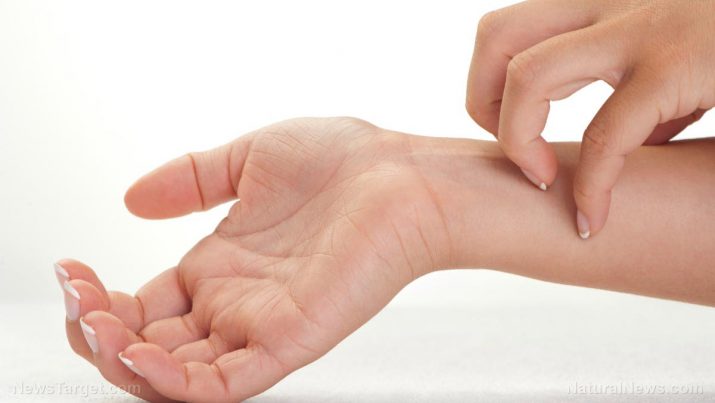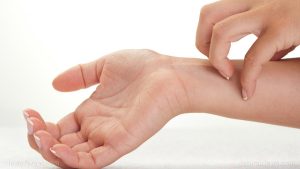
Pityriasis versicolor – causes, side effects and treatments at NaturalPedia.com
Wednesday, July 11, 2018 by Zoey Sky
http://www.naturalpedia.com/pityriasis-versicolor-causes-side-effects-and-treatments-at-naturalpedia-com.html

Pityriasis versicolor (PV) refers to a common fungal skin infection in adolescents and young adults. The infection causes discolored patches, mostly pale (hypopigmented) spots on the upper back and shoulders, to appear in the skin of the patient.
Pityriasis versicolor is caused by a yeast (Malassezia furfur, M. furfur) that produces a substance which suppresses color production in the skin. This substance makes pale spots appear in the patient’s skin. If an individual has lighter skin, the spots may be light brown or pink instead.
Pityriasis versicolor is the alternative name for tinea versicolor (TV) and there are some specialists who prefer the former since it technically pertains to non-yeast, dermatophyte fungal infections, fungus that affects the body (like ringworm/tinea corporis), feet (athlete’s foot/tinea pedis), or the groin (jock itch/tinea cruris).
Since the cause of tinea versicolor is a yeast rather than a true dermatophyte fungus, the term pityriasis versicolor (meaning “spots of different colors”) is technically the more accurate term to use. However, the technically inaccurate name “tinea versicolor” is more commonly used to refer to the condition.

Known symptoms of pityriasis versicolor
The signs of pityriasis versicolor usually include noticeable discolored patches of skin on a patient’s arms, back, chest, and neck.
These discolored patches of skin can be:
- Brown, pink, tan, or red
- Dry, itchy, and scaly
- Lighter or darker than the surrounding skin – This is the most common signs among patients with PV.
- More prominent with tanning
- Prone to disappear in cooler and less humid weather
Another sign of the condition is itchy skin.
Patients with dark skin who develop pityriasis versicolor may experience hypopigmentation, or the loss of skin color. Meanwhile, other individuals can experience hyperpigmentation, or their skin turns darker.
Other patients with PV don’t experience any notable changes in their appearance or skin color.
Risk factors for pityriasis versicolor may include:
- Age – The condition is most common in teenagers and people in their 20s.
- Environment – Around the globe, PV is more common in hot, humid environments. It is rarer in dry northern nations.
- Gender – Pityriasis versicolor is more common in males than females.
In some cases, the condition worsens in hot and humid environments and seasons, which is common among yeast and fungal infections.
Body systems harmed by pityriasis versicolor
Pityriasis versicolor may cause complications like hypopigmentation. This can last even after several months of successful treatment. Hypopigmentation may persist until the skin becomes tanned again. But if the rash isn’t scaly when scratched, the infection is considered cleared.
Food items or nutrients that may prevent pityriasis versicolor
The following foods or nutrients can help prevent pityriasis versicolor or address its signs:
- Cloves – Patients can chew cloves or drink clove tea (cloves, lemon juice, or a teaspoon of baking soda or apple cider vinegar in a glass of water) daily to help reduce fungal growth.
Garlic – Garlic has potent anti-fungal properties. Include at least two or three cloves of garlic in a meal to help control the signs of PV. - Raw fruits, vegetables, and whole grains – A patient’s diet must include lots of antioxidant-rich raw fruits, vegetables, and whole grains that can boost the immune system. Consume broccoli, green beans, and green leafy vegetables at least four times weekly to prevent the fungal infection. Other sources include citrus fruits, onions, raw pumpkin seeds, and sweet potatoes. Patients can also benefit from eating whole grain variants of couscous, oatmeal, pasta, and rice.
- Yogurt – Patients can consume yogurt daily to help maintain the balance between the healthy bacteria and fungi in the body. This can prevent the excessive growth of fungi. Yogurt can also prevent the infection from spreading.
Treatments, management plans for pityriasis versicolor
If a patient doesn’t experience the severe signs of pityriasis versicolor, their condition may be treated at home. It can be hard to prevent the recurrence of PV.
Treatment options include:
- Medications – Healthcare professionals may prescribe medications, like topical creams or pills, to treat the condition.
- Over-the-counter (OTC) antifungal creams or shampoos – These can help kill the infection.
Patients who have been diagnosed with PV and successfully treated it can follow these tips to prevent future infections:
- Avoid excessive sweating.
- Avoid exposure to excessive heat.
- Avoid tanning or excessive sun exposure.
Where to learn more
- Home Remedies for Yeast Infection – Top 10 Amazing Treatments
- Natural compounds to kill off yeast
- Natural Remedies for Yeast Infections and Candida
- Tinea Versicolor Natural Treatment
- Yeast Infection: Description, Causes and Treatment
Summary
Pityriasis versicolor (PV) refers to a common fungal skin infection in adolescents and young adults that causes discolored spots to appear on the upper back and shoulders of the patient.
The signs of pityriasis versicolor usually include noticeable discolored patches of skin on the arms, back, chest, and neck.
Pityriasis versicolor may cause complications like hypopigmentation.
Cloves; garlic; raw fruits, vegetables, and whole grains; and yogurt can help prevent pityriasis versicolor or address its signs.
If a patient doesn’t experience the severe signs of pityriasis versicolor, their condition may be treated at home. It can be hard to prevent the recurrence of PV. Treatment options for PV include medications and over-the-counter (OTC) antifungal creams or shampoos.
Sources include:
Tagged Under: Tags: pityriasis versicolor





